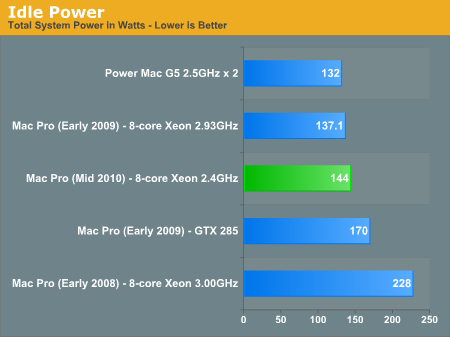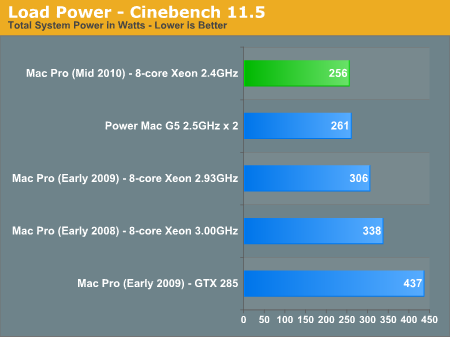Apple Mac Pro (Mid 2010) Review
by Anand Lal Shimpi on October 6, 2010 9:26 PM ESTPower Consumption
The big advantage of Westmere is power consumption. If we compare last year’s Mac Pro with the GeForce GT 120 idle power consumption is actually lower than the new Westmere system thanks to the Radeon HD 5770 drawing more power at idle. If you look at the 2009 Mac Pro with a GeForce GTX 285 however, the 5770/2010 Mac Pro has a significant idle power advantage.

The same is true under load, although the GPU plays less of a role in our Cinebench render test for load power. The Mac Pro we’re testing here is clocked much lower than our 2009 Mac Pro, which explains some of the power advantage but not all of it.

We’ve been tracking Mac power consumption in OS X vs. Windows for quite a while now. I decided to see how power consumption changed under Boot Camp. As expected, idle power was a bit higher while load power consumption was identical:
| Power Consumption Comparison | ||||
| Mac Pro (Mid-2010) | Mac OS X 10.6.4 | Windows 7 x64 | ||
| Idle | 144W | 159W | ||
| Load (Cinebench 11.5) | 256W | 253W | ||
The 15W difference in idle power usage is significant, but honestly it matters a lot less in a system like the Mac Pro than a mini or MacBook Pro. The Cinebench scores are identical under both OSes in case you were wondering. This wasn't always true, Apple has significantly improved OS X performance with 10.6.x vs Leopard.










84 Comments
View All Comments
Stuka87 - Thursday, October 7, 2010 - link
Uhm, this is the first Apple System they have reviewed in quite some time. If you click under systems up top, you will see pages of PC's, along with a review for the current gen Mac Mini last spring, and a MacBook Pro review. And there is an iPhone 4 review and AppleTV review. But these are pieces of tech that people like. Just like the 500 PC reviews and other misc. hardware.Anand Lal Shimpi - Thursday, October 7, 2010 - link
Apple gets equal treatment along with the rest of the stuff we review around here. In fact, the Mac Pro review got pushed back for months to accommodate more pressing things like the Sandy Bridge performance piece, the associated architecture article and testing for the next SSD piece.There have been a lot of Apple related articles lately but that's simply because Apple recently announced a lot. This clears out the last of the backlog. Next on the list are SSDs, HDDs and some other unmentionables... :-P
I appreciate you visiting frequently :)
Take care,
Anand
shambla - Thursday, October 7, 2010 - link
I am considering picking up an entry level Mac Pro, but I am a little concerned about future upgrade options. I understand that the daughter board in the uniprocessor model is different from that in the DP models, but is the main logic board identical to that in the dual processor Mac Pro models?More importantly, will the daughter board in the 2.8GHz Nehalem uniprocessor model allow me to upgrade to ANY of the uniprocessor variant Westmere CPUs sometime down the line, or am I restricted to Nehalem Xeons? Could I for example put in a single W3680 3.33GHz 6-core Westmere CPU in a year or two? I know that Apple offer this CPU as a build-to-order option for the uniprocessor Mac Pro, but does this require them to use a different daughter board?
Nadav2010MP - Friday, October 8, 2010 - link
Hello Shambla,In answer to your question, the main logic board(backplane board) has only one firmware version for both single and dual set ups. The firmware for the 2010 is: MP51.007F.B00 and the SMC firmware is 1.39/f11 for both the logic board and processor boards(single and dual), so yes the main backplane board's firmware is for both the single and dual.
As far as being able to upgrade to any westmere cpu, the answer is YES. For instance, when I did my upgrade by removing the 09 parts from my 09 mac pro and replacing them with 2010, the processor board already has the B1 stepping support built in, along with the D0 nehalem stepping so that you can upgrade the w3530 2.8 to a w3680... The same can be said for me.. I have a w3580 3.33 4-core DO Nehalem processor, and I can easily use the Westmere 6-core w3680 as a drop in replacement - the board's firmware accepts both Nehalem and Westmere cpus.
There is only one part number for the single-processor board. It wouldn't make sense for Apple do deny customers the right to upgrade to the w3680 later on, since the firmware supports both D0 AND B1.. Here are the part numbers:
Single-processor board: 661-5707
Backplane board: 661-5706
Dual-processor board: 661-5708
***THE DUAL WOULDN'T MAKE ANY SENSE AND I WILL TELL YOU WHY. Unlike the single-quad core which you would have, the same heatsink also works on the 6-core w3680(that same heatsink also is the same on the 2009 mac pro).. Why the dual option doesn't work is because not only do you have to get the dual board, but you also have to BUY the dual cpu heatsinks which alone would cost close to 400.00. Then the processors themselves are EXTREMELY EXPENSIVE..
The single-quad upgrade makes sense as the processors aren't too bad.. For me, who had a 2009 originally, for 300 dollars I was able to buy just the backplane board and processor board - while using my existing 09 parts(fans, case, heatsink etc..). In essence, my w3580 works great in the 661-5707 board and rightfully so because it doesn't make sense to just limit the firmware to support only 2.8,3.2 and 3.33 6-core... rather, the firmware supports all, and I MEAN ALL D0 and B1 stepping processors.. Here is my system profiler:
Model Name: Mac Pro
Model Identifier: MacPro5,1
Processor Name: Quad-Core Intel Xeon
Processor Speed: 3,33 GHz
Number Of Processors: 1
Total Number Of Cores: 4
L2 Cache (per core): 256 KB
L3 Cache: 8 MB
Memory: 6 GB
Processor Interconnect Speed: 6.4 GT/s
Boot ROM Version: MP51.007F.B00
SMC Version (system): 1.39f11
SMC Version (processor tray): 1.39f11
As you can see, the changes in firmware are visible here.. MP51.007F.B00 and SMC 1.39F11 for both backplane and processor board.. and originally my parts were 09 parts.. And yes, I am using the w3580 processor - the 2009 lineup's top of the line in the 2010 processor board, and as you can see it fully works as if it were a 2009... But, I also have the capability to use 1333 mhz memory with it since the w3580 supports 1333 along with its other brother the w3680.
shambla - Sunday, October 10, 2010 - link
Many thanks for the thorough reply - I assumed I would be fine to just drop a single 4 or 6 core Westmere into the standard uniprocessor daughterboard, since as you said, it makes no sense for Apple to use 2 parts when one is sufficient and I assumed that the Nehalem and Westmere CPUs would be similar enough that there would be no technical reason why this would not be possible. I completely agree that trying to upgrade the uniprocessor model to a dual processor system would be prohibitively expensive, given the additional parts I would require, hence my interest in using one of the 6-core Westmere CPUs instead. Thanks again for the helpHighjnx - Thursday, December 16, 2010 - link
Out of curiosity where are you able to find the backplane and processor boards for the 2010 at $300. I'm not finding either one for less than $450 = $900 US Dollars.Also I've got half a dozen X5670 chips in hand and would be curious to know if one of those would work on the single board in place of the W3680.
Any input is appreciated.
DominionSeraph - Sunday, October 10, 2010 - link
Why would you get the base Mac Pro? You can get a 980X with 24GB and SLI'd 1GB GTX 460's for ~$100 less than the Mac Pro's quad core, 3GB, and 5770.shambla - Sunday, October 10, 2010 - link
Well for a start I get educational discount which knocks something like 15% off the list price straight away. I can get the base model for just over £1600 or get it upgraded to 6GB plus swap the 5770 for the 5870 for just under £2000. I have priced up broadly similar systems using both i7 and Xeon CPUs, but in the UK, last time I checked the 980X CPU alone would cost me around £750, the pair of 460s would be around £350 and 24Gb of tri-channel RAM would be around £450. That's £1550 before I have added a suitable motherboard, PSU, case, storage etc. Plus I like OS X, it's as simple as that. Finally, if I want to free up some cash a couple of years down the line, a Mac Pro, like most other Apple systems, maintains value like no other system you can buy or build yourself.pr0nstar69 - Thursday, October 7, 2010 - link
Somebody already mentioned this in passing, but there is another horrible mistake in the price comparison: the Dell comes with a 3 Year warranty and support, as well as NBD exchanges, whereas the basic price for the Mac Pro only includes one year of warranty and support, as well as the pleasure of carrying your Mac Pro to an Apple Store.If you want to compare apples with apples, you have to at the very least add AppleCare to the Mac Pro, $249 extra. So the total "Apple tax" is more like $574, when warranty and the graphics card are taken into account.
I don't think that falls into "minimal". Especially because you'd have to be an idiot to buy a Dell workstation at the list price on the Dell website. One call to sales or to your own Dell representative should give you at the very least a few percent off, and for companies that buy Dell equipment regularly more like tens of percent.
Anand Lal Shimpi - Thursday, October 7, 2010 - link
Very true, I've updated the cost comparison to equalize along warranty as well.Both Apple and Dell can offer significant discounts if you have a relationship with them. Going through Apple's Business representatives can easily save 3 - 10% off pretty much anything. I've kept discounts out of the equation simply because they are hard to track and do vary based on a number of factors.
Take care,
Anand